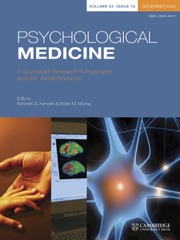Article contents
Neighborhood as a predictor of non-aggressive, but not aggressive, antisocial behaviors in adulthood
Published online by Cambridge University Press: 04 June 2015
Abstract
Prior meta-analytic work has highlighted important etiological distinctions between aggressive (AGG) and non-aggressive rule-breaking (RB) dimensions of antisocial behavior. Among these is the finding that RB is influenced by the environment more than is AGG. Relatively little research, however, has sought to identify the specific environmental experiences that contribute to this effect. The current study sought to do just this.
We examined whether unrelated adults residing in the same neighborhood (n = 1915 participants in 501 neighborhoods) were more similar in their AGG and RB than would be expected by chance. Analyses focused on simple multi-level models, with the participant as the lower-level unit and the neighborhood as the upper-level unit.
Results revealed little to no evidence of neighborhood-level variance in AGG. By contrast, 11+% of the variance in RB could be predicted from participant neighborhood, results that persisted even when considering the possibility of genetic relatedness across participants and neighborhood selection effects. Moreover, 17% of this neighborhood-level variance in RB was accounted for by neighborhood structural characteristics and social processes.
Findings bolster prior suggestions that broader contextual experiences, like the structural and social characteristics of one's neighborhood, contribute in a meaningful way to RB in particular. Our results also tentatively imply that this association may be environmental in origin. Future work should seek to develop additional, stronger designs capable of more clearly leveraging genetic un-relatedness to improve causal inferences regarding the environment.
Information
- Type
- Original Articles
- Information
- Copyright
- Copyright © Cambridge University Press 2015
References
- 8
- Cited by

